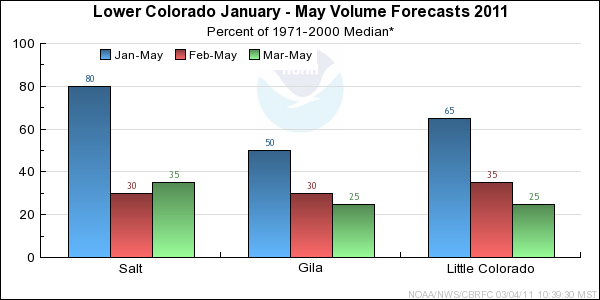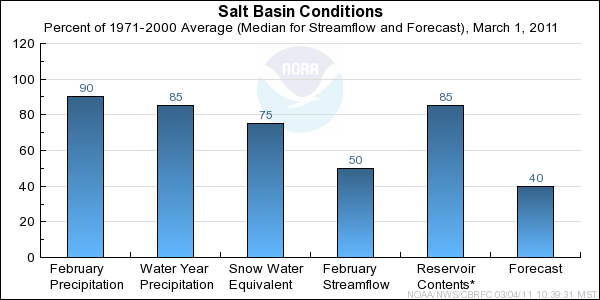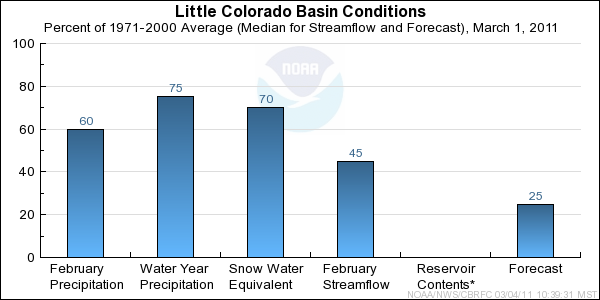
NOAA, National Weather Service
Colorado Basin River Forecast Center
Salt Lake City, Utah
www.cbrfc.noaa.gov
 | Prepared by G. Smith NOAA, National Weather Service Colorado Basin River Forecast Center Salt Lake City, Utah www.cbrfc.noaa.gov |




| Forecast Period | 90% Exceedance Volume | 50% Exceedance Volume | Percent Median | 10% Exceedance Volume | |
| Salt | |||||
| Roosevelt, Nr | March-May | 35 | 60 | 22 | 120 |
| Tonto Ck | |||||
| Roosevelt, Nr, Gun Ck, Abv | March-May | 2.3 | 10 | 38 | 39 |
| Verde | |||||
| Blo Tangle Ck, Abv Horsehoe Dam | March-May | 35 | 60 | 42 | 130 |
| Forecast Period | 90% Exceedance Volume | 50% Exceedance Volume | Percent Median | 10% Exceedance Volume | |
| Gila | |||||
| Gila, Nr | March-May | 5.5 | 9 | 26 | 18.6 |
| Virden, Nr, Blue Ck, Blo | March-May | 8 | 10 | 21 | 24 |
| Solomon, Nr, Head Of Safford Vly | March-May | 21 | 24 | 23 | 55 |
| San Carlos Res, Coolidge Dam, At | March-May | 5 | 8 | 12.5 | 45 |
| San Francisco | |||||
| Glenwood, Nr | March-May | 4 | 5 | 30 | 13.6 |
| Clifton | March-May | 9 | 12 | 29 | 35 |
| Forecast Period | 90% Exceedance Volume | 50% Exceedance Volume | Percent Median | 10% Exceedance Volume | |
| Little Colorado | |||||
| Lyman Lk, Abv, St. Johns, Nr | March-June | 0.34 | 1.5 | 24 | 4.1 |
| Woodruff | March-May | 0.15 | 0.4 | 18.2 | 4.2 |
| Rio Nutria | |||||
| Ramah, Nr | March-May | 0.02 | 0.4 | 14.8 | 1.7 |
| Zuni | |||||
| Black Rock Res, Abv | March-May | 0.02 | 0.15 | 16.9 | 2.5 |
| Cebolla Ck | |||||
| Ramah Res | March-May | 0 | 0.25 | 16.8 | 2.3 |
| East Clear Ck | |||||
| Blue Ridge Res, Pine, Nr | March-May | 1.4 | 4.5 | 35 | 10.2 |
| Clear Ck | |||||
| Winslow, Nr | March-May | 3.2 | 7 | 23 | 15 |
| Chevelon Ck | |||||
| Winslow, Nr, Wildcat Cyn, Blo | March-May | 1.4 | 4 | 31 | 9 |
| Walnut Ck | |||||
| Lake Mary | March-May | 0.8 | 1.5 | 37 | 3.7 |
| Usable Capacity | EOM Contents | Percent Usable Capacity | Last Year EOM | Last Year %Capacity | |
| Salt | |||||
| Roosevelt | 1653.0 | 1508.3 | 91 | 1644.3 | 99 |
| Horse Mesa | 245.0 | 228.9 | 93 | 229.5 | 94 |
| Mormon Flat | 58.0 | 56.4 | 97 | 55.0 | 95 |
| Stewart Mountain | 70.0 | 68.0 | 97 | 64.3 | 92 |
| Horseshoe | 109.2 | 3.2 | 3 | 97.0 | 89 |
| Bartlett | 178.0 | 145.6 | 82 | 164.4 | 92 |
|
| |||||
| TOTAL | 2313.2 | 2010.4 | 87 | 2254.4 | 97 |
| Little Colorado | |||||
| Lyman Lake | 31.0 | 19.9 | 64 | 12.8 | 41 |
| Bill Williams | |||||
| Alamo | 1045.0 | 134.2 | 13 | 200.6 | 19 |
| Agua Fria | |||||
| Lake Pleasant | 1145.0 | 738.2 | 64 | 773.5 | 68 |
| Gila | |||||
| San Carlos | 885.0 | 113.6 | 13 | 172.5 | 19 |
| Painted Rock | 2476.0 | 0.0 | 0 | 1.3 | 0 |
| Colorado | |||||
| Lake Powell | 24322.0 | 13235.0 | 54 | 13780.2 | 57 |
| Lake Mead | 27380.0 | 11121.0 | 41 | 11774.0 | 43 |
| Lake Mohave | 1810.0 | 1698.4 | 94 | 1680.4 | 93 |
| Lake Havasu | 619.0 | 558.9 | 90 | 547.5 | 88 |
|
| |||||
| TOTAL | 59713.0 | 27619.2 | 46 | 28942.9 | 48 |
| Range | Round to | |
| 0-1.99 | 0.01 | |
| 2.0-19.9 | 0.1 | |
| 20-199 | 1.0 | |
| 200-999 | 5.0 | |
| 1000+ | 3 significant digits |